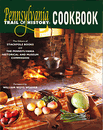Military Moves on its Stomach
This article originally appeared in Pennsylvania Trail of History Cookbook
During World War I, soldiers' rations contained more items than they had previously. Though lacking in vitamin A, the rations kept the soldiers relatively healthy, a difficult task in trench conditions. They were expensive, however, and exceeded the ration allowance. To combat the rising costs, new items such as bacon, lard, onions, canned tomatoes, and margarine were introduced at the end of the war.
By the time America entered World War II, rations were more standardized and environment based. There were rations designed for the individual and the detachment, for use in the field or in combat.
Two familiar rations introduced at that time were C and K rations. C rations consisted of six cans - three with a meat and a vegetable, and the other three with crackers, sugar, and coffee. Packed with 2,974 calories, C rations were considered too bulky for use by mobile troops. K rations, adopted in 1942, were created to meet the needs of paratroopers, tank crews, and other soldiers who depended on mobility for survival. Both kinds of rations remained in service for decades, feeding troops in Korea and Vietnam.
During World War II, Allied POWs in Europe, dubbed "Kriegies" by the Germans, received German rations supplemented by Red Cross packages and found creative ways to spice up their diet. "Kriegie ice cream" was prepared by beating snow with powdered milk and sugar until fluffed, then topping with jam. "Macaroni and cheese" consisted of broken-up crackers, milk, and sliced cheese heated together.
The Pennsylvania Military Museum, Boalsburg, Centre County, honors and tells the story of America's citizen soldiers.
Visit
Pennsylvania Military Museum, Boalsburg, PA
A museum that honors Pennsylvania's citizen soldiers.
For Further Reading
 |
Pennsylvania Trail of History Cookbook Edited by Kyle R. Weaver, Diane B. Reed, and Fred Lauver Forward by William Woys Weaver Stackpole Books and Pennsylvania Historical and Museum Commission 2004 |
 |
Pennsylvania Military Museum: Pennsylvania Trail of History Guide by Arthur and Marjorie Miller Stackpole Books and Pennsylvania Historical and Museum Commission 2005 |

